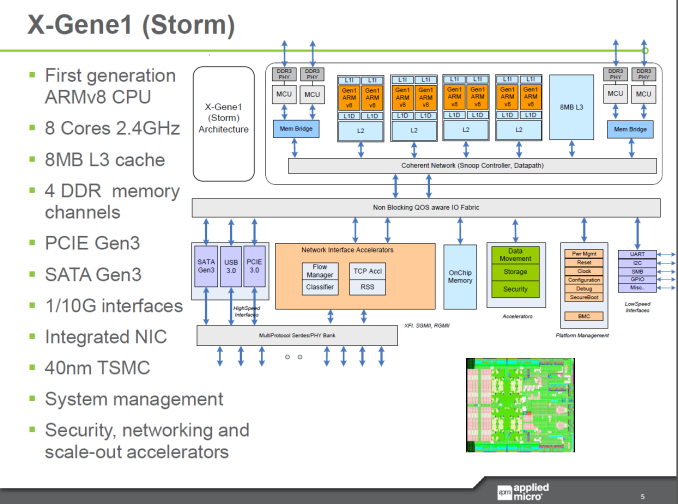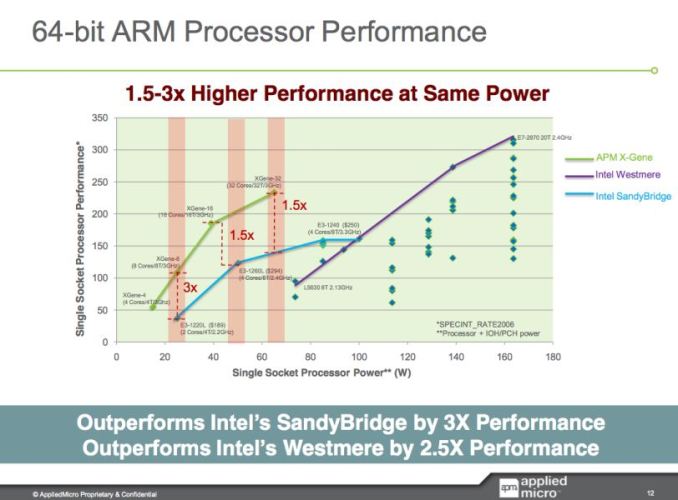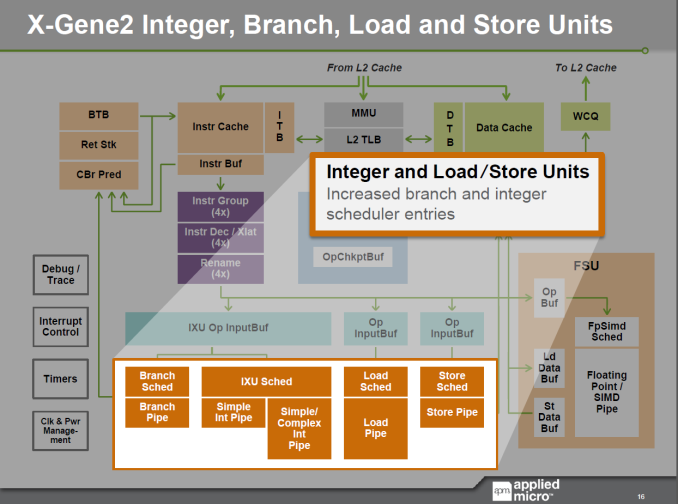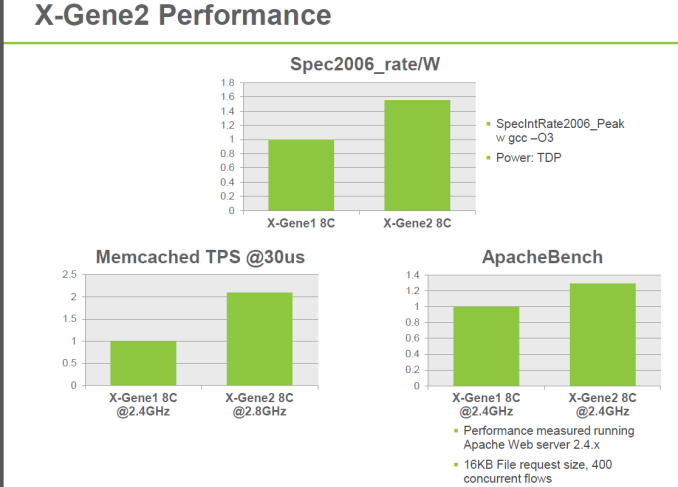ARM Challenging Intel in the Server Market: An Overview
by Johan De Gelas on December 16, 2014 10:00 AM ESTThe ARM Based Challengers
Calxeda, AppliedMicro and ARM – in that order – have been talking about ARM based servers for years now. There were rumors about Facebook adopting ARM servers back in 2010.
Calxeda was the first to release a real server, the Boston Viridis, launched back in the beginning of 2013. The Calxeda ECX-1000 was based on a quad Cortex-A9 with 4MB L2. It was pretty slow in most workloads, but it was incredibly energy efficient. We found it to be a decent CPU for low-end web workloads. Intel's alternative, the S1260, was in theory faster, but it was outperformed in real server workloads by 20-40% and needed twice as much power (15W versus 8.3 W).
Unfortunately, the single-threaded performance of the Cortex-A9 was too low. As a result, you needed quite a bit of expensive hardware to compete with a simple dual socket low power Xeon running VMs. About 20 nodes (5 daughter cards) of micro servers or 80 cores were necessary to compete with two octal-core Xeons. The fact that we could use 24 nodes or 96 SoCs made the Calxeda based server faster, but the BOM (Bill of Materials) attached to so much hardware was high.
While the Calxeda ECX-1000 could compete on performance/watt, it could not compete on performance per dollar. Also, the 4GB RAM limit per node made it unattractive for several markets such as web caching. As a result, Calxeda was relegated to a few niche markets such as the low end storage market where it had some success, but it was not enough. Calxeda ran out of venture capital, and a promising story ended too soon, unfortunately.
AppliedMicro X-Gene
Just recently, AppliedMicro showed off their X-Gene ARM SoCs, but those are 40nm SoCs. The 28nm "ShadowCat" X-Gene 2 is due for the H1 of 2015. Just like Atom C2000, the AppliedMicro X-Gene ARM SoC has four pairs of cores that share an L2 cache. However, the similarity ends there. The core is a lot beefier and it features 4-wide issue with an execution backend with four integer pipelines and three FP pipelines (one 128-bit FP, one Load, one Store). The 2.4GHz octal-core X-Gene also has a respectable 8MB L3 cache and can access up to four memory channels, with an integrated dual 10GB Ethernet interface. In other words, the X-Gene is made to go after the Xeon E3, not the Atom C2000.
Of course, the AppliedMicro chip has been delayed many times. There were already performance announcements in 2011. The X-Gene1 8-core at 3GHz was supposed to be slightly slower than a quad-core Xeon E3-1260L "Sandy Bridge" at 2.4GHz in SPECINT_Rate2006.
Considering that the Haswell E3 is about 15-17% faster clock for clock, performance should be around Xeon E3-1240L V3 at 2GHz. But the X-Gene1 only reached 2.4GHz and not 3GHz, so it looks like an E3-1240L v3 will probably outperform the new challenger by a considerable margin. The E3-1230L (v1) was a 45W chip and the E3-1240L v3 is a 25W TDP chip, and as a result we also expect the performance/watt of an E3-1240L to be considerably better. Back in 2011, the SoC was expected to ship in late 2012 and have two years lead on the competition. It turned out to be two months.
Only a thorough test like our Calxeda review will really show what the X-Gene can do, but it is clear that AppliedMicro needs the X-Gene2 to be competitive. If AppliedMicro executes well with X-Gene2, it could get ahead once again... this time hopefully with a lead of more than two months.
Indeed, early next year, things could get really interesting: the X-Gene2 will double to the amount of cores to 16 (at 2.4GHz) or up the clock speed to 2.8GHz (8-cores) courtesy of TSMC's 28nm process technology. The X-Gene2 is supposed to offer 50% more performance/watt with the same amount of cores.
AppliedMicro also announced the Skylark architecture inside X-Gene3. Courtesy of TSMC's 16nm node, the chip should run at up to 3GHz or have up to 64 cores. The chip should appear in 2016, but you'll forgive us for saying that we first want to see and review the X-Gene2 before we can be impressed with the X-Gene3 specs. We have seen too many vendors with high numbers on PowerPoint presentations that don't pan out in the real world. Nevertheless, the X-Gene2 looks very promising and is already running software. It just has to find a place in a real server in a timely fashion.














78 Comments
View All Comments
jhh - Tuesday, December 16, 2014 - link
SPARC and Power have had trouble keeping up with Moore's law, as neither sold enough to amortize R&D to push out innovation at the same rate as Intel. As Moore's law comes to an end, this will stop being a unique Intel advantage. It just might be too late for both of them. One can see the pressure on IBM, with their opening the Power architecture in similar ways to ARM. Both POWER and SPARC have to keep up to porting drivers to their Unix implementations, while the device manufacturers either write drivers for Linux or don't get volume. I just can't see either POWER or SPARC being cost effective over the long run. And, when others see the same thing, they aren't going to be excited about porting application software to those platforms.ARM needs to have a good performance/power and performance/cost ratio to get people excited to buy something other than Intel. They are certainly getting enough volume from the low-end to make investment on high-end parts. So far, I'm not excited enough to recommend any ARM proof-of-concept though.
Kevin G - Wednesday, December 17, 2014 - link
IBM always had a licensing model similar to ARM with PowerPC cores. The only thing really new here is that IBM is licensing out there flagship POWER chip in the same manner. Despite Intel having a process advantage, IBM was able to keep up in performance. (The 45 mm based 8POWER7 was generally faster than the 32 mm 10 core Westmere-EX.) There will always be a market for top performance but you are correct that sustaining on just that customer base is unwise.IBM does realize that their software licensing model to subsidize hardware R&D was not sustainable. So while you can't run AIX, you can get a POWER8 box for less than $3k now.
OreoCookie - Wednesday, December 17, 2014 - link
Really, just $3000? Wow, how times have changed, I remember ~12 years ago that a single Alpha CPU cost that much (the department I was working for had a workstation fail, fortunately under warranty, because otherwise they would have had to pay for 2 new CPUs and new RAM worth about 15,000 German Marks).Ratman6161 - Wednesday, December 17, 2014 - link
"The general lower cost of Linux and open source software" While it's true that the cost of a Linux OS including support is lower than an equivalent Windows OS, in the larger scheme of things the cost of Windows and even VMware becomes little more than background noise in the total cost of operations. Try pricing out an Oracle DB for example and you find that the cost of that software dwarfs the price of the hardware it's running on as well as whatever the OS is costing. Ditto with most "enterprise software".lefty2 - Tuesday, December 16, 2014 - link
Intel has another big advantage over ARM, which everyone seems to have forgotten about, and that is software compatibilty. 64-bit ARM server software is still a work in progress. The stuff that's being worked on at the moment is open source. Once that's finished you still have to convince clients to convert their proprietary software to ARM.JohanAnandtech - Tuesday, December 16, 2014 - link
Don't you think that the open source software that has been/is ported now is enough? Apache/PHP/MySQL, Memcached and Hadoop...that is a massive server market. And there is little stopping Microsoft to invest in ARM software too. Just VMware might be a bit tricky, but I don't think the software is a problem.Kevin G - Wednesday, December 17, 2014 - link
Actually VMware has said some less that flattering about ARM. Xen is the main hyper visor on ARM for the moment.goop666666 - Thursday, December 25, 2014 - link
Yeah, recompiling is so very hard. Essentially what you're saying is that Intel is for legacy systems and software that is poorly written. That is a large enough market, but doesn't apply to hyperscale deployments, which are the future.gostan - Tuesday, December 16, 2014 - link
great article by Johan as always.but the argument is muted. we have heard this tune before.
the hardware might be cheaper. the power bill might be cheaper. wait until you see the software maintenance cost. custom software needs 'custom' pricing.
besides, arm has no cutting edge fab process to back them.
JohanAnandtech - Tuesday, December 16, 2014 - link
You do not need expensive software to create a server market these days. Just look how many webservers are running the LAMP stack.